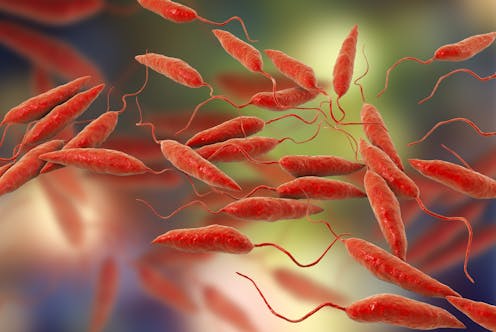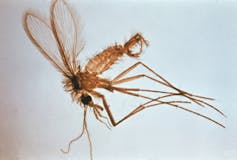
In recent decades, Europe has seen a worrying increase in cases of vector-borne tropical diseases like dengue, malaria and chikungunya. The climate directly affects the spread and distribution of pathogen-transmitting insects like mosquitoes and sandflies, as their life cycle and survival are linked to temperature and humidity.

Leishmaniasis is one of the tropical diseases that is spreading due to global warming, and features in the World Health Organisation’s list of neglected tropical diseases. It is actually a group of ailments caused by the parasite Leishmania, transmitted by the bite of insects called phlebotomine sandflies. These insects are smaller and hairier than mosquitoes, with wings that they hold in a “V” shape when at rest.
Leishmaniasis has a number of different clinical manifestations. The cutaneous form causes sores on the skin that may develop into painful ulcers, and the mucocutaneous variant affects the membranes of the nose, mouth and throat, causing wounds that can permanently disfigure the patient. However, the most serious is the visceral form, which affects internal organs such as the liver and spleen, causing fever, weight loss and anaemia. If not treated in time, it can cause death.
Unlike other tropical infections, it is present in southern European countries as as a zoonotic disease, meaning it is transmitted from animals to humans. Caused by the species Leishmania infantum, its main domestic carrier is dogs.
It is distributed in hotspots – areas with the right environmental and epidemiological conditions for transmitting the parasite – and where there are high numbers of sandflies and dogs. The main victims are young children and immunocompromised adults.
A frightening spread through Europe
In recent years, an increase in cases has been observed in areas of Europe where the disease is endemic, such as Portugal, Northern Italy, Greece and the Balkans.
However, a recent survey conducted by the European Centre for Disease Prevention and Control (ECDC) revealed that it is not mandatory to report cases of leishmaniasis in all countries with locally transmitted cases, and that few countries monitor or control infections in animals or humans.
A lack of preparation and reactive, rather than preventive, attitudes on the part of European governments have contributed significantly to the disease’s spread.
The increase in cases has been directly linked to global warming: it is estimated that an average one degree rise in air temperature leads to a significant uptick in cases of leishmaniasis. Warmer conditions increase the survival and mobility of sandflies, the density of their populations, the number of bites, and the development of the parasite within them. Longer summers extend the period of transmission and the risk of infecting hosts, be they humans or dogs.
Global warming also encourages the northward movement of vector populations, leading to local transmission from imported cases in areas where the disease was not previously endemic. Currently, sandflies are already widespread throughout the Iberian Peninsula, northern Italy and the Balkans, but they reach as far as Germany. Further spread is expected in the coming years.
Movement of people is making things worse
Along with climate change, another aggravating factor is the increasing movement of people and pets, including travel and forced migration. Although it has been suggested that the arrival of refugees in Europe could pose a risk for the introduction of new Leishmania species (such as L. tropica and L. donovani), these species are already sporadically present in Europe, specifically in Greece and Cyprus.
The greatest risk is actually the movement of millions of tourists from the north to the Mediterranean coast. This not only affects people, but also pets: a large number of infected dogs live in non-endemic areas, and can become the source of the parasite that establishes a local source of transmission.
Another factor associated with the rise of leishmaniasis in Europe is the increase in the number of immunocompromised people. Like in the 1990s, when HIV-Leishmania co-infection led to a resurgence of leishmaniasis in southern Europe, many new cases are being reported in people who have received an organ transplant, or are receiving immunosuppressive treatment. These circumstances increase their susceptibility to developing the disease in case of infection.
A leishmaniasis outbreak was detected in Sweden among patients undergoing immunosuppressive treatment who had visited the Mediterranean coast, highlighting the high rate of transmission. Were it not for the vulnerable nature of these patients, these cases could well have gone completely unnoticed.
An additional threat is the parasite’s apparently growing resistance to the few available pharmaceutical treatments. In Europe, it is common to treat dogs suffering from canine leishmaniasis, but treatment is not always successful, and animals can relapse. This causes the parasite to develop resistance over time, which also affects treatment in humans.
Additionally, the parasite can develop resistance while in the bodies of sandflies, without any kind of medical intervention. Weaker parasites can become stronger when they come into contact with stronger ones from animals or humans that have previously received treatment.
A change of attitude is urgently needed
We need to understand that leishmaniasis is a growing concern for public health in Europe. Measures to reduce and control it are imperative – these can include monitoring human and canine cases, the spread of sandflies, the parasite’s resistance to drugs, and its emergence in previously non-endemic regions.
Governments have the opportunity to take preventative, instead of reactionary, measures. This will allow them to predict and anticipate the spread of this disease, and to be more prepared to confront that challenges that it presents.
Francisco Javier Moreno Nuncio receives support from various governmental, national and international funding agencies, and from non-profits. He has participated as an expert advisor in World Health Organisation meetings.
Christopher Fernandez-Prada receives funding from the Canadian Institutes of Health Research (CIHR), the Natural Sciences and Engineering Research Council of Canada (NSERC), the Canada Foundation for Innovation (CFI), the Québec Nature and Technologies Research Fund ( Fonds de recherche du Québec – Nature et technologies, FRQNT), and the J.-Louis Lévesque Foundation.
This article was originally published on The Conversation. Read the original article.







